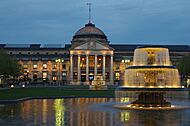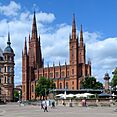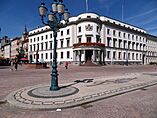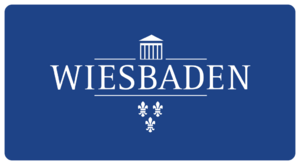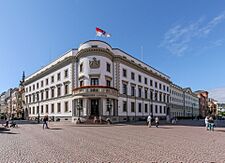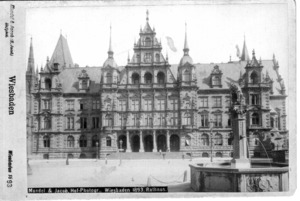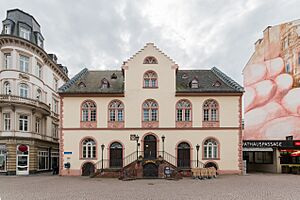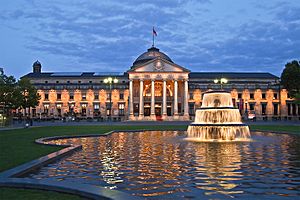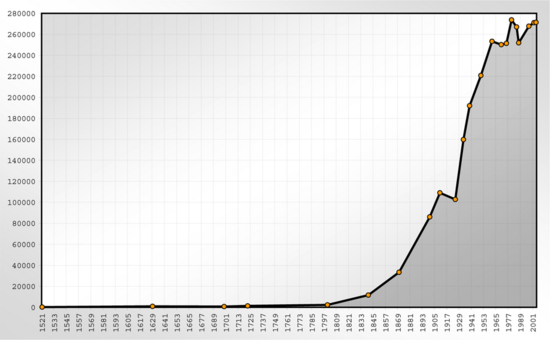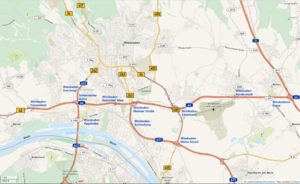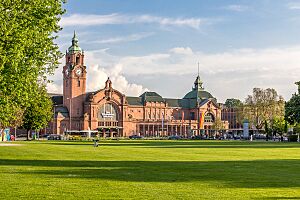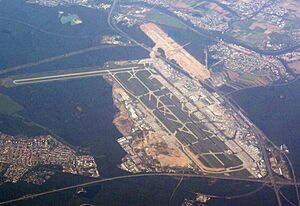Wiesbaden facts for kids
Quick facts for kids
Wiesbaden
|
|||
|---|---|---|---|
|
View over Wiesbaden from Neroberg
Kurhaus Wiesbaden
Russian Church
Neroberg Funicular
Mountain Church
Market Church
City Palace
Biebrich Palace
|
|||
|
|||
| Country | Germany | ||
| State | Hesse | ||
| Admin. region | Darmstadt | ||
| District | Urban district | ||
| Founded | 121 | ||
| Elevation | 115 m (377 ft) | ||
| Population
(2022-12-31)
|
|||
| • Total | 283,083 | ||
| Time zone | CET/CEST (UTC+1/+2) | ||
| Postal codes |
65183–65207
55246 (Mainz-Kostheim) 55252 (Mainz-Kastel) |
||
| Dialling codes | 0611, 06122, 06127, 06134 | ||
| Vehicle registration | WI | ||
Wiesbaden is a big city in Germany. It is the capital of the state of Hesse. The name "Wiesbaden" means "meadow baths," which is a clue about one of its most famous features: its hot springs!
Wiesbaden is the second-largest city in Hesse, after Frankfurt am Main. About 283,000 people live here. It's part of a larger area called the Rhine-Main Metropolitan Region. This region is home to over 5.8 million people.
The city sits by the Rhine river, at the foot of the Taunus mountains. It's right across from Mainz, another important German city. Wiesbaden is also in a famous wine-growing area called Rheingau. This means you'll find many vineyards nearby.
Some parts of Wiesbaden used to belong to Mainz until 1945. This history sometimes causes a friendly rivalry between the two cities. Wiesbaden is also known for being one of the oldest spa towns in Europe. It has 15 mineral springs, and 14 of them are hot! These springs produce about 2 million liters of water every day.
Because of its location, Wiesbaden has a mild climate. It's sometimes called the "Nice of the North" because of its nice weather and beautiful buildings. It's also one of the wealthiest cities in Germany. The United States Army Europe and Africa has its main office here too.
Contents
- What is Wiesbaden Like?
- A Look Back in Time: Wiesbaden's History
- Fun Things to Do and See
- How People Live in Wiesbaden
- Getting Around Wiesbaden
- Important Organizations and Economy
- Culture and Festivals
- Sports
- Sister Cities
- Coat of Arms
- Famous People from Wiesbaden
- Rivalry with Mainz
- Images for kids
- See also
What is Wiesbaden Like?
Wiesbaden is located on the right side of the Rhine river. The river's main direction changes here from north to west. The city is directly across the Rhine from Mainz. Frankfurt am Main is about 38 kilometers (24 miles) to the east. The Taunus Mountains are to the north.
The city center is in the northeastern part of the Upper Rhine Valley. It's about 5 kilometers (3 miles) from the Rhine river. The area is a wide valley surrounded by hills.
Small streams flow through the city, like the Salzbach. Many thermal and mineral springs also flow into these streams in the spa area. The highest point in Wiesbaden is near the Hohe Wurzel, which is 608 meters (1,995 feet) above sea level. The lowest point is at the Schierstein harbor, at 83 meters (272 feet) above sea level. The main square, Schlossplatz, is 115 meters (377 feet) high.
Wiesbaden covers an area of 204 square kilometers (79 square miles). It is 17.6 kilometers (10.9 miles) from north to south and 19.7 kilometers (12.2 miles) from west to east. Large forest areas cover 27.4% of the city. Vineyards and farms cover 31.1% of the land. The Rhine river forms 10.3 kilometers (6.4 miles) of the city's border.
Wiesbaden's Weather
Wiesbaden has a mild climate. This means it has relatively cold winters and warm summers. The average temperature for the whole year is 9.8°C (49.6°F). In January, the average temperature is 1.0°C (33.8°F). In July, it's 18.6°C (65.5°F).
| Climate data for Wiesbaden | |||||||||||||
|---|---|---|---|---|---|---|---|---|---|---|---|---|---|
| Month | Jan | Feb | Mar | Apr | May | Jun | Jul | Aug | Sep | Oct | Nov | Dec | Year |
| Mean daily maximum °C (°F) | 4 (39) |
6 (43) |
11 (52) |
15 (59) |
20 (68) |
23 (73) |
25 (77) |
25 (77) |
20 (68) |
14 (57) |
8 (46) |
5 (41) |
14.7 (58.5) |
| Daily mean °C (°F) | 1.0 (33.8) |
2.2 (36.0) |
5.5 (41.9) |
9.4 (48.9) |
13.8 (56.8) |
17.0 (62.6) |
18.6 (65.5) |
18.0 (64.4) |
14.6 (58.3) |
10.0 (50.0) |
4.9 (40.8) |
2.1 (35.8) |
9.8 (49.6) |
| Mean daily minimum °C (°F) | −1 (30) |
−1 (30) |
2 (36) |
5 (41) |
9 (48) |
12 (54) |
14 (57) |
14 (57) |
11 (52) |
7 (45) |
3 (37) |
1 (34) |
6.3 (43.3) |
| Average precipitation mm (inches) | 48 (1.9) |
41 (1.6) |
46 (1.8) |
41 (1.6) |
55 (2.2) |
68 (2.7) |
66 (2.6) |
63 (2.5) |
49 (1.9) |
49 (1.9) |
57 (2.2) |
55 (2.2) |
638 (25.1) |
| Average precipitation days (≥ 1 mm) | 10 | 8 | 8 | 9 | 10 | 10 | 10 | 10 | 8 | 8 | 10 | 10 | 111 |
| Source: Sonnenlaender.de | |||||||||||||
A Look Back in Time: Wiesbaden's History
People have lived in the Wiesbaden area since the Stone Age. But its recorded history began when the Romans built a fort there in 6 AD. The hot springs were famous even then. Roman soldiers used them for their horses.
Ancient Times: Romans and Tribes
The Roman settlement was first called Aquae Mattiacorum in 121 AD. This means "Waters of the Mattiaci." The Mattiaci were a local Germanic tribe. The Romans also built the Limes Germanicus, a border wall, near Wiesbaden.
The Roman capital of the region, Mogontiacum (today's Mainz), was just across the Rhine. It was connected by a bridge. Around 260 AD, a group of Germanic tribes called the Alamanni took over the fort. Later, in the 370s, they helped the Romans defend the area.
After the Franks defeated the Alamanni in 496, the Franks took control. In the 8th century, Wiesbaden became a royal palace site for the Frankish kingdom. The name "Wisabada" was first written down around 828-830.
The Middle Ages: Castles and Counts
When the Frankish empire split up in 888, Wiesbaden became part of East Francia. This area later became the Holy Roman Empire. In the 1170s, the Count of Nassau gained control of Wiesbaden.
In 1232, Wiesbaden became an "imperial city." This meant it was directly under the Holy Roman Emperor. However, in 1242, the city was destroyed during a war. Wiesbaden returned to the House of Nassau in 1270. But it was destroyed again in 1283 in another conflict.
A count named Adolf from Nassau later became king of Germany from 1292 to 1298. In 1329, the House of Nassau was given the right to make its own coins. In 1355, the Nassau lands were divided, and Wiesbaden became the seat of one of these parts.
Modern History: From Duchy to Capital
In 1525, Wiesbaden lost its special rights for over 40 years because it joined a peasant uprising. During this time, the city became Protestant. The oldest building still standing in Wiesbaden, the old city hall, was built in 1609-1610. Earlier buildings were destroyed by fires.
By 1648, after the Thirty Years' War, only about 40 people lived in Wiesbaden. In 1744, Biebrich Palace became the main home for the rulers of Nassau. In 1771, gambling was allowed in Wiesbaden. The Wiesbaden Casino opened in 1810.
In 1806, the Holy Roman Empire ended. Wiesbaden became the capital of the new Duchy of Nassau. The city started to look grand with many new buildings. The Wiesbaden City Palace became the main home for the Duke in 1841.
In 1866, Nassau sided with Austria in a war against Prussia. When Austria lost, Prussia took over Nassau. Wiesbaden then became part of a Prussian province. This change was good for the city. It became a famous international spa town. Many rich people, artists, and nobles moved here. Even Kaiser Wilhelm II visited Wiesbaden every summer. By the late 1800s, Wiesbaden had more millionaires than any other German city.
World War II and After
After World War I, French and British armies occupied Wiesbaden. In 1925, it became the headquarters for the British Army of the Rhine. An airport was built in 1929.
During a sad event in 1938, Wiesbaden's main synagogue was destroyed. Many Jewish people living in Wiesbaden were later forced to leave their homes and were sent to places where many people died.
In World War II, Wiesbaden was a military headquarters. The city was bombed 66 times between 1940 and 1945. About 18% of homes were destroyed, and 1,700 people died. American forces captured Wiesbaden on March 28, 1945. After the war, famous American artist Elvis Presley often visited Wiesbaden.
After World War II, the state of Hesse was created, and Wiesbaden became its capital. Wiesbaden was not as badly damaged by bombs as Frankfurt. The United States Army Europe headquarters are now located in Wiesbaden.
In 1962, artists like George Maciunas and Dick Higgins held concerts in Wiesbaden. These events helped start the "Fluxus" art movement.
Fun Things to Do and See
Wiesbaden has always been famous for its hot springs and spas. The Romans were the first to use them. By 1370, there were 16 bath houses. By 1900, Wiesbaden had 126,000 visitors each year. Famous people like Johann Wolfgang von Goethe and Fyodor Dostoevsky visited the springs.
Gambling also became popular. The Wiesbaden casino was very famous. It was closed in 1872 but reopened in 1949.
The Palace Square
The Schloßplatz (palace square) is in the city center. It's surrounded by important buildings. The ducal palace was built between 1837 and 1841. It was once the home of the ruling family. Today, it's the parliament building for the state of Hesse.
The new town hall was built in 1887. The old town hall, built in 1610, is the oldest building in the city center. It's now used for civil ceremonies. The Protestant Marktkirche (market church) was built in a neo-Gothic style. Its steeple is 92 meters (302 feet) tall, making it the highest building in the city.
The Kurhaus and Theater
The impressive Kurhaus (spa house) was built between 1904 and 1907. It has a famous casino. In front of the Kurhaus is a large lawn called the Bowling Green. Next to it is the Kurhaus Colonnade, a long hall supported by pillars. The Hessisches Staatstheater Wiesbaden (State Theater) is also nearby.
Churches and Other Cool Places
St. Bonifatius is a Catholic church built from 1845 to 1849. It has a beautiful Gothic Revival style. The Russian Orthodox Church of Saint Elizabeth was built on the Neroberg hill. It was built by Duke Adolf of Nassau for his wife who passed away.
North of the city is the Neroberg hill. From the top, you can see amazing views of the city. The Nerobergbahn is a funicular railway that takes you up the hill. The Nerotalanlagen is a park along a creek, created in 1897-1898.
The Museum Wiesbaden is one of the three state museums in Hesse. Other churches include the Bergkirche and the Lutherkirche. The Warmer Damm park is a lovely 4.5-hectare park with a lake and fountain. It was created in 1859-1860.
How People Live in Wiesbaden
Wiesbaden has about 280,000 people. In 1946, when it became the capital of Hesse, it had about 188,000 people. Many Americans moved to Wiesbaden after the 1950s because of military jobs. Many people who work in Frankfurt also live in Wiesbaden.
Wiesbaden is a very international city. People from over 180 countries live here. The largest groups of foreign residents include people from Turkey, Poland, Italy, and Ukraine.
Getting Around Wiesbaden
Wiesbaden has great connections to Germany's motorway system. The Bundesautobahn 3 (A 3) and Bundesautobahn 66 (A 66) meet at the Wiesbadener Kreuz interchange. The A 66 connects Wiesbaden with Frankfurt.
The city center streets can get busy during rush hour. Important roads include Taunusstrasse and Wilhelmstrasse.
Trains and Public Transport
Wiesbaden's main train station connects the city to Frankfurt, Mainz, and other places. You can take fast ICE trains to major German cities like Hamburg and Munich. Regional trains and buses help people get around the wider area.
Wiesbaden is part of the Frankfurt S-Bahn network. Three S-Bahn lines connect Wiesbaden to the busy Rhine Main Region. This makes it easy to reach nearby cities like Mainz and Frankfurt. The city's bus service, ESWE Verkehr, has 45 lines that connect all parts of the city to downtown.
Airports
You can fly to Wiesbaden from all over the world through Frankfurt Airport. It's only about 15 kilometers (9 miles) east of Wiesbaden. It's one of the busiest airports in the world. You can reach it by car or train. The S-Bahn train takes about 30 minutes from the airport to Wiesbaden Central Station.
There's also Frankfurt Hahn Airport, but it's about 100 kilometers (62 miles) away. It's mainly used by low-cost airlines.
Port
Wiesbaden also has small container port operations on the Rhine and Main rivers.
Important Organizations and Economy
Many international companies have their German or European offices in Wiesbaden. These include Abbott Laboratories, Ferrari, and Porsche. Several German companies also have their main offices here.
The "Industriepark Kalle-Albert" is a large industrial park in Wiesbaden. It has over 80 companies that work in the pharmaceutical and chemical fields.
The Federal Criminal Police Office and the Federal Statistical Office of Germany are both located in Wiesbaden. Many government ministries for the state of Hesse are also here.
Wiesbaden is a very wealthy city. It has the second-highest gross domestic product per person in Hesse, after Frankfurt.
Culture and Festivals
Wiesbaden's main stage for performances is the Hessisches Staatstheater Wiesbaden. The Kurhaus has a concert hall called the Friedrich-von-Thiersch-Saal. Wiesbaden also has a State Library and a music school. Choirs like the Wiesbadener Knabenchor are well-known.
International May Festival
The International May Festival is a yearly arts festival. It's held by the Hessisches Staatstheater Wiesbaden every May. It started in 1896 and is one of the most famous theater and music festivals in the world. It features plays, musicals, operas, ballets, concerts, and more.
Rheingau Wine Festival
Every August, Wiesbaden hosts the Rheingauer Weinwoche (Rheingau Wine Week). This ten-day festival celebrates the wines and sparkling wines from the nearby Rheingau region. Vintners offer their wines at over 100 booths. Thousands of visitors come to try the different types of Riesling wines. There's also food and music.
Rheingau Music Festival
Since 1988, the Rheingau Musik Festival has held summer concerts in the Marktkirche and the Kurhaus concert hall.
Sports
Since 2007, Wiesbaden has been home to SV Wehen Wiesbaden, a football (soccer) team. The club was promoted to the 2. Bundesliga in 2019, which is a high level of professional football in Germany.
Sister Cities
Wiesbaden has "twin" or "sister" cities around the world. This means they have special friendships and cultural exchanges. The first twinning was with Klagenfurt in Austria in 1930.
 Klagenfurt, Austria (1930)
Klagenfurt, Austria (1930) Montreux, Switzerland (1953)
Montreux, Switzerland (1953) Friedrichshain-Kreuzberg (Berlin), Germany (1964)
Friedrichshain-Kreuzberg (Berlin), Germany (1964) Ghent, Belgium (1969)
Ghent, Belgium (1969) Fondettes, France (1975)
Fondettes, France (1975) Ljubljana, Slovenia (1977)
Ljubljana, Slovenia (1977) Kfar Saba, Israel (1981)
Kfar Saba, Israel (1981) San Sebastián, Spain (1981)
San Sebastián, Spain (1981) Wrocław, Poland (1987)
Wrocław, Poland (1987) Royal Tunbridge Wells, England, United Kingdom (1989)
Royal Tunbridge Wells, England, United Kingdom (1989) Görlitz, Germany (1990)
Görlitz, Germany (1990) Ocotal, Nicaragua (1990)
Ocotal, Nicaragua (1990) Fatih, Turkey (2012)
Fatih, Turkey (2012) Kamianets-Podilskyi, Ukraine (2023)
Kamianets-Podilskyi, Ukraine (2023)
Coat of Arms
Wiesbaden's coat of arms shows three fleurs-de-lys. These are stylized lily symbols. The design is blue with two gold lilies on top and one gold lily below.
Famous People from Wiesbaden
Many interesting people were born in or lived in Wiesbaden:
- Adolphe, Grand Duke of Luxembourg (born 1817), a former ruler.
- Adolphus Busch (1839–1913), who founded the famous Anheuser-Busch company.
- Biruté Galdikas (born 1946), a famous scientist who studies orangutans.
- Jürgen Grabowski (1944–2022), a well-known football player.
- Franz Kaiser (1891–1962), an astronomer who discovered asteroids named after Wiesbaden.
- Michael Kessler (born 1967), an actor and comedian.
- Günther Lütjens (1889–1941), a German admiral during World War II.
- John McEnroe (born 1959), a famous American tennis player (born on a U.S. military base).
- Nico Rosberg (born 1985), a Finnish-German racing driver who won the Formula One World Championship in 2016.
- Volker Schlöndorff (born 1939), a film director.
- Kiki VanDeWeghe (born 1958), an American basketball player and coach.
- Valerie Weigmann (born 1989), a Filipino-German actress and beauty queen.
- Richard Wagner, a famous composer, lived in Biebrich (now part of Wiesbaden) and started writing one of his operas there.
- Elvis Presley and Priscilla Presley lived in Wiesbaden. Priscilla met Elvis here!
- Reese Witherspoon, an American actress, lived in Wiesbaden with her parents.
- Mayte Garcia, a dancer and actress, lived here and met the singer Prince.
Rivalry with Mainz
Mainz, across the Rhine river, is Wiesbaden's friendly rival. Both cities are capitals of their states. People from both cities often joke about the other side of the river!
Images for kids
See also
 In Spanish: Wiesbaden para niños
In Spanish: Wiesbaden para niños


